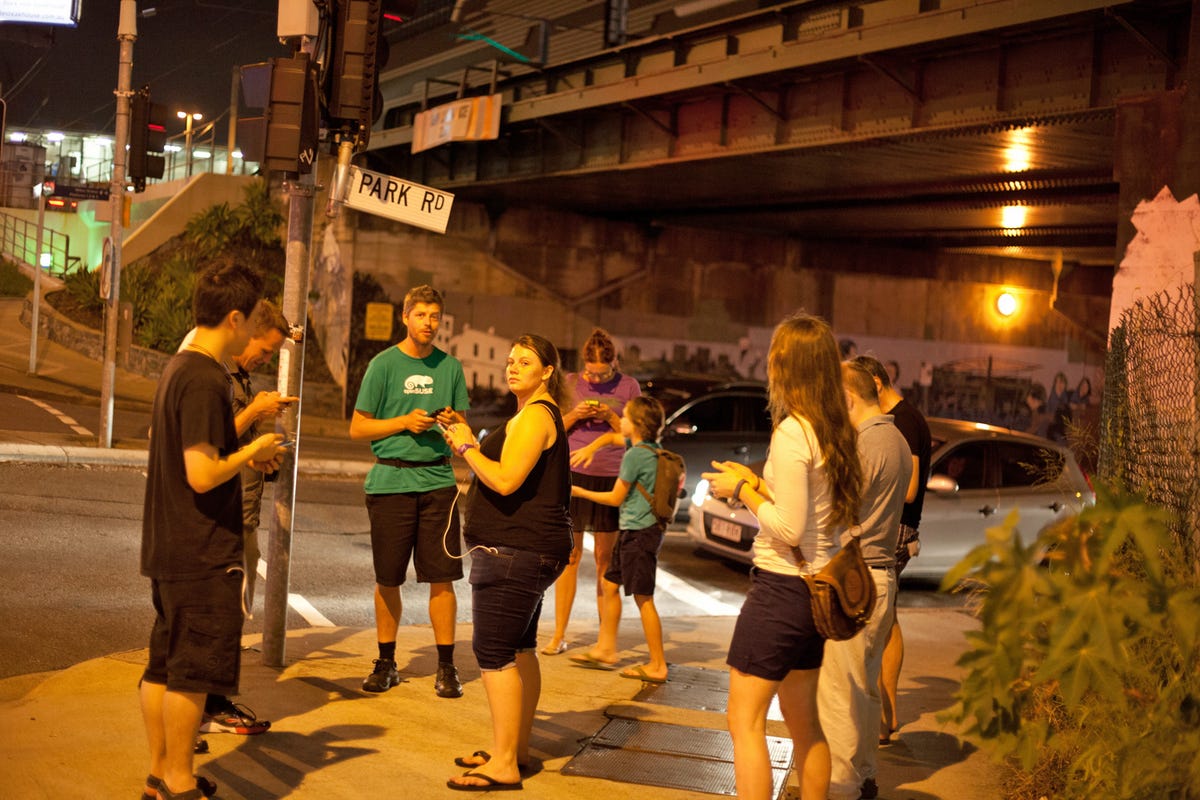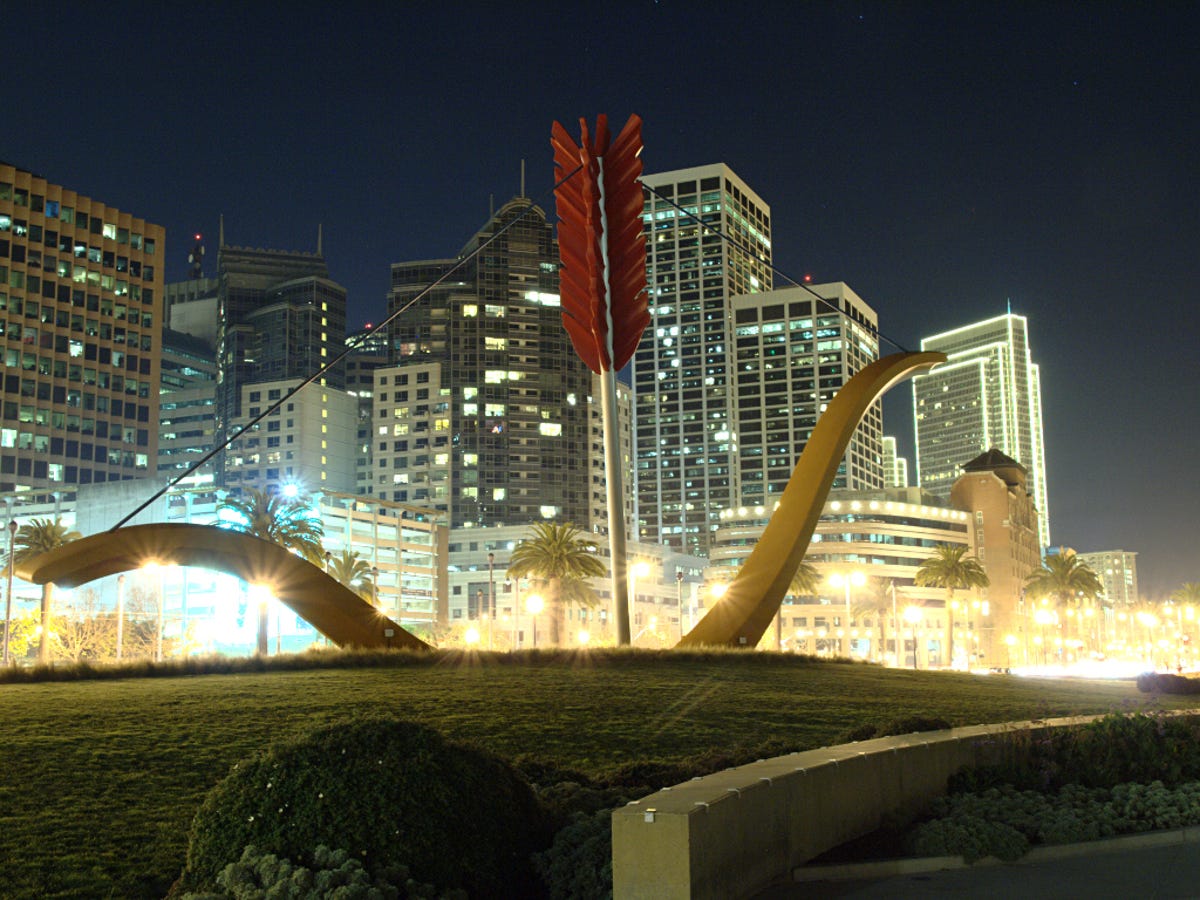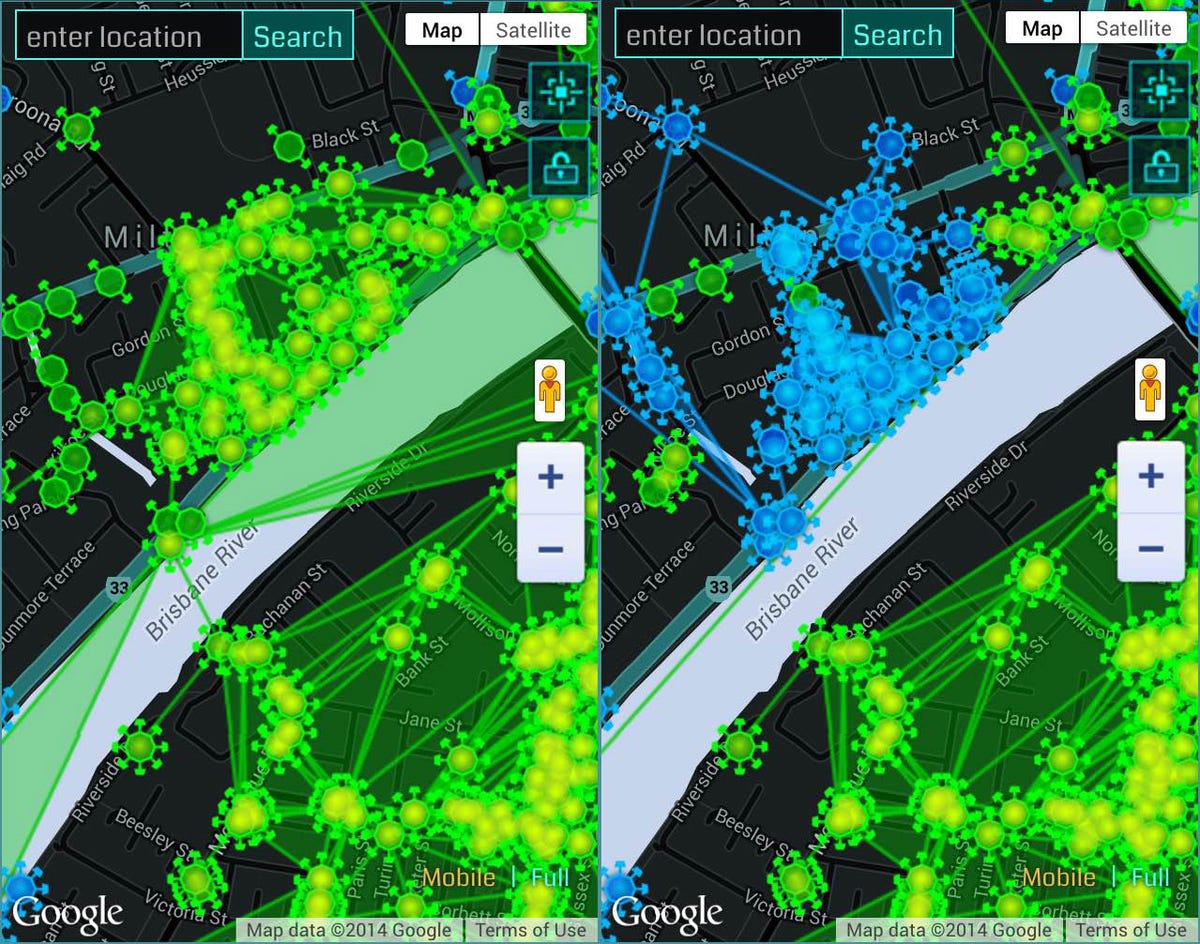Eleven of us gather deep in the enemy heartland on a balmy Sunday evening to partake in Operation: Green Court. Meeting in secret, we are agents of the Enlightened, a faction which seeks to advance society through our actions. The enemy will be unaware of our presence until we begin attacking and capturing a long corridor of their prized portals, flipping them from blue to green while figuratively flipping them the bird. Our movements must be coordinated and efficient, as it won’t be long before we attract the attention of the Resistance, the opposing faction which fears change and seeks to crush our idealism and progress.
In actuality, we are 10 adults and one child meeting on a street corner to bond over our smartphones — specifically, an app called Ingress, a free-to-play augmented reality game that has been downloaded over 8 million times and is being played in more than 200 countries.
The massively multiplayer mobile game encourages its players to walk around the real world, using data overlaid atop Google Maps to attack and defend real-world public locations known as “portals”. Our common goal for this operation is to turn the suburb green — the colour of the Enlightened, and the colour of the shirt of Aladrin, the 39 year-old agent who arranged this operation via Google+ earlier in the week.
Milton — an inner-city suburb of Brisbane, Australia — is usually coated in blue, thanks to the dedicated efforts of its Resistance population, many of whom work at nearby IT firms. Our own neighbourhood, just across the Brisbane River, is firmly green-held, but on this Sunday night we’ve set out to ruffle a few blue feathers. Owing to their team colour, Resistance players are commonly referred to as “Smurfs”. The Enlightened tend to self-identify as “frogs”.
Among the eleven of us is Apocs85, a dedicated level 15 agent who is widely known and respected as the unofficial guardian of Brisbane’s West End. The 29-year-old loves his day job of testing video games, and his Ingress statistics show that he has walked 118 kilometres (73 miles) in the last week while defending and rebuilding portals throughout the inner-city.
Niantic’s ‘success failure’
In-game action is shown on our smartphone screens, which act as “scanners” to reveal the portals located all around us. They’re invisible to the naked eye, but with Ingress loaded on our Android or iOS devices, we’re able to see portals attached to structures, artwork, historic locations and buildings of cultural significance — train stations, public parks and post offices are three common examples.
The portal locations are user-submitted and manually checked by staff at Niantic Labs, the game’s Google-owned developer, to ensure their accuracy and suitability. Globally, more than 3 million such locations have been approved so far, in numbers far greater than expected when the game was first released as a public beta version in November 2012.
“At Google, we call that a ‘success failure’,” says Niantic Labs founder John Hanke with a chuckle. “It’s a failure because it’s so successful: lots of people submitted portals, which is great, but now it’s more than we can really handle to keep the response time down.”
In an effort to speed up the process, developers are investigating the implementation of a crowd-sourced approach to these submissions. On the scanner, nearby portals are coloured grey when in a neutral state, but each one can be captured by members of either faction by attaching up to eight “resonators”, which denote ownership. Portals can be linked together only if an agent holds a key for each; linking three portals in a triangle creates a “field”.
Playing Ingress
Keys and items — resonators, weapons, items and mods, in the Ingress parlance — are attained by hacking portals. “Action points”, or AP, are gained via interacting with portals, and serve as Ingress’s experience points.
While exploring the world, small blue particles known as “exotic matter”, or XM, are collected; these are important, as performing any in-game action costs the player XM, and these energy levels are being constantly depleted. By gaining AP, XM and badges, players gradually rise through the ranks from level one through to the current peak of level 16.
These are the rudiments of playing Ingress at a basic level, though for those willing to invest their time in the game, its further complexities and intricacies soon begin to reveal themselves.


Andrew McMillen/CNET
The 11 of us meet on an innocuous street corner situated at 21 Park Road, Milton, beside a portal named Temple Door. Within a 40-metre (130-foot) radius — illustrated on our scanners by a yellow ring — we can attack, capture or recharge portals associated with nearby restaurants, landmarks and public artworks, but to reach other portals, we must proceed on foot. As the group sets off in single file, heads down, eyes on screens, the sight is so strange that we immediately attract curious stares from nearby diners and drivers idling at red lights. Aladrin becomes the proverbial mother duck, leading his ducklings on an efficient and laughter-filled tour of the streets surrounding Milton’s main strip.
A 44-year-old agent named StariZeleni is the oldest member of tonight’s operation. He is Bosnian, and retains a slight accent; his agent name means “old green” in his native tongue. He began playing in February 2013, when the game was in beta, and has recently returned to Ingress after a self-imposed sabbatical. “In the beginning, it was incredible how many people my age and older were playing the game,” he says as we walk between backstreet portals, using our “XMP burster” weapons to neutralise blue resonators with satisfying, circular flashes. “That’s how we used to play as kids; there weren’t computers, so we were going out, exploring and doing stuff out in the world. Now, most kids are just sitting at home, playing games. They don’t go out.”
The origins of Ingress are rooted in finding a solution for that very problem: playing video games is traditionally a sedentary activity tied to negative health outcomes. While the recent proliferation of smartphones and Facebook apps mean that more people than ever are playing video games, the stereotype of the pasty, overweight, basement-dwelling gamer endures, if only as a hangover from the previous generation of console-based gaming. If such players can be convinced to exercise more often, and get a little sunlight at the same time, they might well live longer, and become happier and healthier in every aspect.
“When we first launched, there was some scepticism,” says John Hanke of Niantic Labs, the game’s San Francisco-based developer. “A lot of people debated whether gamers would get off the couch or not. There was a camp of people in the game development world who said, ‘That won’t work — gamers want to sit and play, you have to feed them compulsion loops, and it has to work in a certain way.'”
Three weeks prior to Operation: Green Court, Hanke tells me he designed the game partly for himself, to indulge a long-standing habit of leaving work during the day to visit undiscovered places. “I deeply, deeply enjoy that aspect of Ingress. For me, it’s about that physical movement through the world; an excuse to take a turn I might not take. That’s wonderful. It’s just a little nudge that can cause you to change your behaviour.” With a laugh, he says, “I also use it as an excuse to drag my kids out of the house when they don’t want to.”
Hanke’s desk at Niantic Labs overlooks the San Francisco-Oakland Bay Bridge. While we speak, ferries and cargo ships float past on the water, and traffic zips across the bridge. His agent name is Ace, and he’s a level 9 agent of the Enlightened — “pushing level 10,” he says proudly. Given that he’s been playing for at least two years, I’m a little surprised that he hasn’t attained a higher level. He shrugs. “The quest for AP and levelling is really not for me,” he says. “I prefer to play in small bursts, with ‘explore and discover’ as an objective, versus racking up AP through hardcore grinding. Both ways of playing are awesome.”
Hanke’s Enlightenment
Why Enlightened? I ask. “We tried to make neither faction ‘the enemy’,” he replies. “Neither are evil, at least in the eyes of the people that are part of that faction. My interpretation of the Enlightened is that they’re reconnecting with life, in an almost Zen way. They’re people who are willing to take a moment and appreciate the world. That’s the philosophy for me.”
Among Niantic Labs’ 50 or so staff, Resistance and Enlightened numbers are split fairly evenly, a fact which generally holds true among the global game community. This natural self-balancing act surprised Hanke and his team, as they expected to have to tweak the game mechanics in order to keep one faction from overwhelming the other. “My theory is that people like a good game,” he says. “They don’t like a runaway, lopsided game. As one side is gaining more power, there’s a natural draw to the underdog faction for new players.”
He tilts the webcam out the window to show me one edge of a striking, enormous structure of a bow-and-arrow named Cupid’s Span, situated out on the Port of San Francisco foreshore. “That’s a very important portal in the lore of Ingress,” he says, referring to the dramatic, sci-fi backstory created by Niantic — which, incidentally, no agent I’ve ever met seems to pay much attention to. “There are some portals near the office that change hands all day long. We get to battle for that one on our lunch hour,” he smiles, gesturing to Cupid’s Span.


Prior to founding Niantic Labs in 2012, Hanke was best known for heading a team named Keyhole, which developed geospatial data visualization software. Keyhole’s technology powers Google Earth; the company was acquired by the search giant in 2004. As former vice president of the company’s “geo” division, Hanke had long dreamed of a way to combine location-tracking software with an interactive, worldwide game that transforms neighbourhoods and cities into sites of intrigue and adventure. Ingress has fulfilled that desire. Hanke describes it as the most fun project he has ever worked on, as it has connected with so many people.
He recounts a recent trip to his hometown in Texas, where, at an otherwise empty terminal at a regional airport, the only other person nearby was tapping away at his phone intently. “I heard the sounds of Ingress emanating from his phone. I walked over and we traded a few stories,” he says. While standing in line at the nearby ferry terminal, he’ll watch, fascinated, as the portals change hands several times. “More than once, somebody has come up to me and said, ‘Oh, you’re the person that’s taking over my portal!'” he says. “And I’ll say, ‘No, it’s my portal, back off!’ — with a big smile.”
These one-on-one interactions are just as valuable to Hanke and his team as some of the enormous, globe-spanning operations, named “anomalies”, which Niantic regularly organises in order to galvanise its player base. These can involve thousands of agents across dozens of countries; more than 52,000 have gathered in live events in 281 cities across the world, including Munich, Dublin and Chicago. The most recent event in December, “Darsana”, featured more than 5,000 agents gathered in Tokyo, Japan.
“Whenever I go to anomalies, I just blend into the crowd,” says Hanke. “Sometimes I’ll play as part of an organised team, which is a blast from my point of view. Sometimes I’ll just linger in the background, watching and listening. Generally people don’t know who I am, and I don’t go out of my way to tell them,” he says, smiling.
After attracting over 8 million downloads in the two years since its beta release in November 2012, Ingress has captured the imagination of players unlike any other augmented reality game before it. Though Hanke says it’s not a huge money-maker, and that Niantic’s parent company isn’t fazed by this, there are plans afoot to attract revenue through location-based advertising, and for Google to sell the game’s API to other developers, who can then build upon what Niantic has learned from this nascent style of immersive, map-based gameplay.
“There’s a tonne of stuff that would make the game deeper and richer that has not yet been constructed,” says Hanke. “But I just feel so grateful to have lots of people using it. It’s the ultimate energiser for me and the team, to hear these stories of people having fun with the game, meeting people, and going to new places. It’s inspiring for us to work harder, and to make it bigger and better.”


Andrew McMillen/CNET
Play local, think global
My own entry to the game was through my partner — agent name: JumpyCat — who became hooked on the adventures-on-foot premise in October, and began leaving the house at all hours of the day and night to capture or defend our neighbourhood portals from Resistance attacks. When I joined her as an Enlightened agent in early November, I felt the same tug of initial incomprehension and curiosity, which was soon followed by understanding and a sense of intrinsic reward as we began walking ever-longer loops of our local portals, and battling for green supremacy whenever we travelled to other suburbs.
The game certainly opens up some new avenues for unique interpersonal interactions. “Are you lost?!” asked one worried, dolled-up woman as we began wandering down a dead-end street toward an uncaptured portal, eyes on our phones. Another night, JumpyCat and I were sitting in the gutter of a darkened street, tapping at our screens within capture range of several portals, only to be met by a handful of other green players who had been monitoring our progress on the intel map and decided to join us. Our bigger group soon fell into the familiar mother-duck-and-ducklings formation while crossing streets and clogging footpath traffic. When we ran into a small group of blue players who had just been attacking the main street of West End, it was all smiles, handshakes and good-humoured banter.
Ingress enables the friendliest turf war imaginable, though those smiles belied an undercurrent of serious competitiveness: none of us on the green team want to sleep under a blue field, as it were, and the same is surely true for agents of the Resistance. Every in-game effort made at a local level feeds into a global scoreboard which delineates regular checkpoints and cycles, at which point the scores reset to zero and the unending battle between colours begins anew. The score measures “mind units”, or MU: the more territory that our team colours in green, the more human minds are brought over to the side of the Enlightened. As they should be, of course: we seek progress. We don’t fear change.
One afternoon, after JumpyCat and I had smugly neutralised a blue field near our home in exchange for a small amount of MU, we were spotted by a viciously territorial Resistance agent as he sped past on his bike. “Boom, boom!” he yelled at us on his way to undo our handiwork, as we doubled over in laughter.
This inherently competitive aspect of the game even rears its head during Operation: Green Court, as some playful rivalry sees fellow frogs running down darkened streets ahead of the pack in order to beat one another to unique portal captures. The game is data-heavy and graphic-intensive, and drains phone battery life quickly; JumpyCat and I are the only ones not carrying external battery packs, which are more or less essential for the serious Ingress agent. After 90 minutes of solid walking, capturing and linking portals, the operation ends outside the apartment building of a notoriously vengeful Resistance agent. The group piles on links and high-end mods such as “very rare portal shields”, in order to make it as difficult, time-consuming and frustrating as possible for him to reclaim the area.
“I’ll take a screenshot. I’m just asking for an intel report on Hangouts,” says Aladrin, tapping at his phone before looking up. “Thanks everyone!” Cooperation is coded into the game’s DNA, and what has taken place tonight is just one of thousands of such operations occurring across the world every day. It’s as inclusive, pure and enjoyable an experience as I’ve had in my two-decade-long gaming career, and I can scarcely wait for the next such operation. A comment made by Apocs85 earlier in the night rings in my ears: “Ingress is not a game, it’s a way of life!”
Our flashmob bids each other farewell and we fade away into the night, returning to our own green heartland across the Brisbane River. Tomorrow is Monday, when many of the local Resistance players will return to their workplaces in Milton. They’ll find these streets to be coloured green, not blue, and on their lunch breaks they’ll undo our hard work by flipping the coloured portals back to blue. Our operation may have annoyed them. They may already be planning a counter-strike on our turf. It could come at any time. We must remain vigilant.




